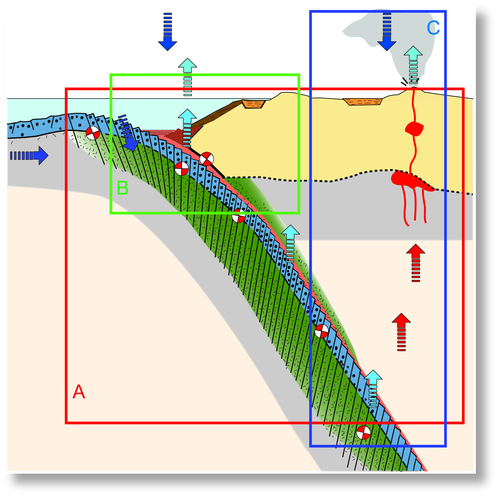 Web Content Display Web Content Display
Scientific ConceptSummary
Figure S-1: Sketch of the subduction zone giving a general idea of the working areas for the different SFB 574 themes. We live on a dynamic planet, which consists of moving lithospheric plates on its surface. New oceanic lithosphere is created beneath the deep ocean at mid-oceanic ridges. From there, they steadily move apart and accumulate biogenic and inorganic materials from the overlying oceans, in particular volatile compounds that are stored within the sediments and in the rocks of the oceanic crust and upper mantle. At subduction zones, oceanic plates sink beneath either a continental margin, as is the case along the entire Pacific margin of Latin America, or beneath another oceanic plate. As the plate is gradually consumed, it releases some of its fluids to the overlying forearc or mantle wedge while transporting others into the Earth's interior. Rising fluids can destabilize gas hydrates (frozen methane) that are abundant in the cold sediments on the continental slope, thereby causing both submarine landslides and related tsunamis and carbon release into the ocean (and possibly the atmosphere). After most pore fluids and chemically bound fluids in clays are released, friction between the plates increases, leading to the most devastating earthquakes on Earth (for example the 1960 Chilean mega-quake, largest earthquake ever recorded) for populations living at these active margins. Deeper in the Earth, fluids are released from the oceanic crust and serpentinized mantle, causing melting of the overlying mantle wedge. These melts rise to the surface forming volcanoes. Especially volatile (gas) - rich magmas can form violent eruptions, emitting huge quantities of climate-influencing gases into the atmosphere. The behavior of fluids in subduction zones thus controls natural hazards such as earthquakes, volcanic eruptions, mass wasting (such as land-sliding) and tsunamis and also affects the compositional evolution of the ocean and the atmosphere. To study the processes involved and their influence on the long- and short-term development of the Earth's climate, SFB 574 investigates the flow of volatiles and fluids into and out of the subduction zones with a wide range of geophysical, petrological, biogeochemical and numerical-modelling methods. The processes involved are addressed by closely interlinked subprojects with well-defined objectives and deliverables, under three overarching themes: A: Subduction zone processes and structure B: Fore-arc volatile turnover and fluid flow C: Slab-arc-atmosphere transfer Since 2006 there is a fourth topic covered by a junior research group: N01: Imaging of fluid distribution SFB 574 started in 2001 and is now entering the last of its three funding periods lasting until June 30, 2012. Results from the Central America subduction system will now be complemented by studying the second target area, the active continental margin off Chile. |
 Events Events
Kieler Wissenschaftler fühlen den 'Puls der Erde' Wie funktioniert die Recyclingmaschine der Erde?Nach elf Jahren endet der Kieler Sonderforschungsbereich 574 zu Subduktionszonen Final colloquium of SFB 574 Teilprojekt ÖffentlichkeitsarbeitMEERESFORSCHUNG FÜR MICH UND DICH |
|
©SFB574 // Wischhofstrasse 1-3 // D-24148 Kiel // T. +49 (0)431 600 1413 // elange [AT] geomar.de






